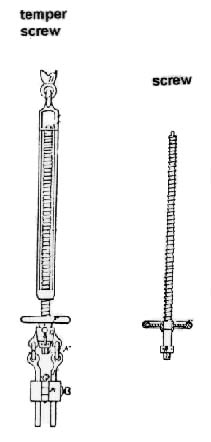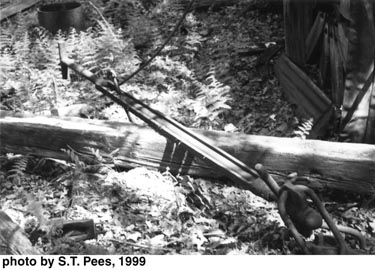 |
||||||
Temper Screw
This drilling feed device was patented in 1865 by R.S. Torrey of Bangor, Maine, as a "Drill rod Attachment". This was the beginning of the modern form of the tool, although it was still to see improvements. A crude form of it was in use earlier for salt well drilling.
As Carll (1880) expressed it, "the temper screw is the connecting link between the walking beam and the cable". Not being a downhole tool it was within reach of the driller at all times when the drill string was in use. Its purpose was to allow the driller to feed out the line in a measured manner concurrent with the deepening of the hole.
The temper screw consisted of a 1 3/8 inch diameter four foot screw with two or more threads to the inch. The screw fitted into an open frame (side pieces or wings) which was four feet six inches long and was attached to the walking beam. A handlebar-like rod (temper bar) at the head (bottom) of the screw allowed the driller to turn it to lengthen the amount of rope in play. Dimensions of the temper screw have varied over the years.
The drawing which illustrates the Walking Beam chapter shows an early cable tool drilling rig (1860's) being operated with a temper screw attached to the walking beam.
Clamps were used beneath the screw, beginning before 1865. The purpose of these clamps was to pinch or hold the line fast as was particularly necessary when the screw had let fully out and was being screwed back up by the driller.
|
||
|
![]()
| © 2004, Samuel T. Pees all rights reserved |
|

